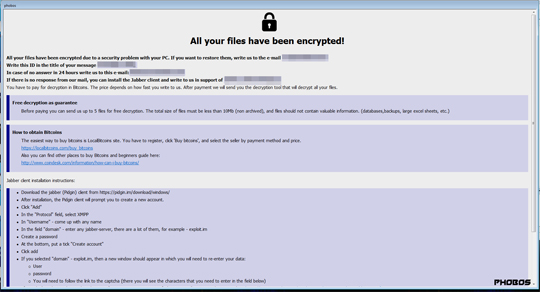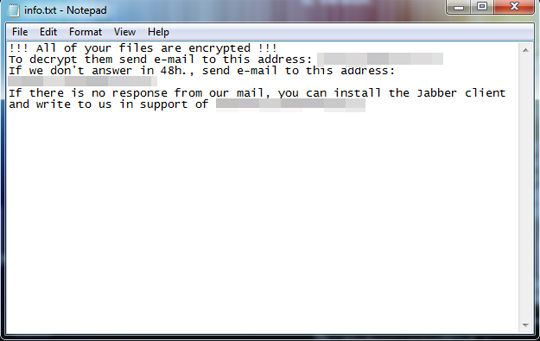Ransom.Win32.PHOBOS.SM
Trojan-Ransom.Phobos (Ikarus)
Windows


Threat Type: Ransomware
Destructiveness: No
Encrypted:
In the wild: Yes
OVERVIEW
This Ransomware arrives on a system as a file dropped by other malware or as a file downloaded unknowingly by users when visiting malicious sites.
It drops files as ransom note.
TECHNICAL DETAILS
Arrival Details
This Ransomware arrives on a system as a file dropped by other malware or as a file downloaded unknowingly by users when visiting malicious sites.
Installation
This Ransomware drops the following copies of itself into the affected system:
- %AppDataLocal%\{Malware Name}.exe
(Note: %AppDataLocal% is the Local Application Data folder, which is usually C:\Documents and Settings\{user name}\Local Settings\Application Data on Windows 2000(32-bit), XP, and Server 2003(32-bit), or C:\Users\{user name}\AppData\Local on Windows Vista, 7, 8, 8.1, 2008(64-bit), 2012(64-bit) and 10(64-bit).)
It adds the following processes:
- netsh advfirewall set curretnprofile state off
- vssadmin delete shadows /all /quiet → delete shadow copies
- wmic shadowcopy delete → delete shadow copies
- bcdedit /set {default} bootstatispolicy ignoreallfailures → disable system's trigger to call the Error Recovery screen on startup
- bcdedit /set {default} recoveryenabled no → Disables Windows Recovery on Startup
- netsh firewall set opmode mode=disable
- "%System%\mshta.exe" "%Desktop%\info.hta"
- "%System%\mshta.exe" "%Public%\desktop\info.hta"
- "%System%\mshta.exe" "{Drive Letter}\info.hta"
(Note: %Desktop% is the current user's desktop, which is usually C:\Documents and Settings\{User Name}\Desktop on Windows 2000(32-bit), XP, and Server 2003(32-bit), or C:\Users\{user name}\Desktop on Windows Vista, 7, 8, 8.1, 2008(64-bit), 2012(64-bit) and 10(64-bit).. %Public% is the folder that serves as a repository of files or folders common to all users, which is usually C:\Users\Public in Windows Vista, 7, and 8.)
Autostart Technique
This Ransomware adds the following registry entries to enable its automatic execution at every system startup:
HKEY_LOCAL_MACHINE\Software\Microsoft\
Windows\CuurentVersion\Run
{Malware Name} = "%AppDataLocal%\{Malware Name}.exe"
HKEY_CURRENT_USER\Software\Microsoft\
Windows\CurrentVersion\Run
{Malware Name} = "%AppDataLocal%\{Malware Name}.exe"
It drops the following file(s) in the Windows User Startup folder to enable its automatic execution at every system startup:
- %User Startup%\{Malware Filename}.exe
(Note: %User Startup% is the current user's Startup folder, which is usually C:\Windows\Profiles\{user name}\Start Menu\Programs\Startup on Windows 98 and ME, C:\WINNT\Profiles\{user name}\Start Menu\Programs\Startup on Windows NT, C:\Documents and Settings\{User name}\Start Menu\Programs\Startup on Windows 2003(32-bit), XP and 2000(32-bit), or C:\Users\{user name}\AppData\Roaming\Microsoft\Windows\Start Menu\Programs\Startup on Windows Vista, 7, 8, 8.1, 2008(64-bit), 2012(64-bit), 10(64-bit).)
It drops the following file(s) in the Windows Common Startup folder to enable its automatic execution at every system startup:
- %Common Startup%\{Malware Name}.exe
(Note: %Common Startup% is the startup folder for all users, which is usually C:\Documents and Settings\All Users\Start Menu\Programs\Startup on Windows 2000, XP, and Server 2003, or C:\ProgramData\Microsoft\Windows\Start Menu\Programs\Startup on Windows Vista, 7, and 8.)
Other System Modifications
This Ransomware adds the following registry keys:
HKEY_CURRENT_USER\Software\Microsoft\
Internet Explorer\International\CpMRU
It adds the following registry entries:
HKEY_CURRENT_USER\Software\Microsoft\
Internet Explorer\International\CpMRU
Enable = 1
HKEY_CURRENT_USER\Software\Microsoft\
Internet Explorer\International\CpMRU
Size = 10
HKEY_CURRENT_USER\Software\Microsoft\
Internet Explorer\International\CpMRU
InitHits = 100
HKEY_CURRENT_USER\Software\Microsoft\
Internet Explorer\International\CpMRU
Factor = 20
Other Details
This Ransomware does the following:
- It avoids encrypting files with the following extensions:
- .docx
- .pptx
- .xlsx
- .xbap
- .html
- .search-ms
- .mpv2
- .dvr-ms
- .mpeg
- .mp2v
- .aiff
- .aifc
- .midi
- .tiff
- .jpeg
- .jfif
- .jpe
- .phobos
- .rar
- .raw
- .rdf
- .rgbe
- .rle
- .rqy
- .rss
- .rtf
- .rw2
- .rwl
- .safe
- .sct
- .sdpx
- .shtm
- .shtml
- .slk
- .sln
- .sql
- .sr2
- .srf
- .srw
- .ssi
- .st
- .stm
- .svg
- .svgz
- .swf
- .tab
- .tar
- .tbb
- .tbi
- .tbk
- .tdi
- .tga
- .thmx
- .tif
- .tiff
- .tld
- .torrent
- .tpl
- .txt
- .u3d
- .udl
- .uxdc
- .vb
- .vbs
- .vcs
- .vda
- .vdr
- .vdw
- .vdx
- .vrp
- .vsd
- .vss
- .vst
- .vsw
- .vsx
- .vtm
- .vtml
- .vtx
- .wb2
- .wav
- .wbm
- .wbmp
- .wim
- .wmf
- .wml
- .wmv
- .wpd
- .wps
- .x3f
- .xl
- .xla
- .xlam
- .xlk
- .xlm
- .xls
- .xlsb
- .xlsm
- .xlsx
- .xlt
- .xltm
- .xltx
- .xlw
- .xml
- .xps
- .xsd
- .xsf
- .xsl
- .xslt
- .xsn
- .xtp
- .xtp2
- .xyze
- .xz
- .zip
Ransomware Routine
This Ransomware avoids encrypting files found in the following folders:
- %Windows%
- %Program Files%
(Note: %Windows% is the Windows folder, where it usually is C:\Windows on all Windows operating system versions.. %Program Files% is the default Program Files folder, usually C:\Program Files in Windows 2000(32-bit), Server 2003(32-bit), XP, Vista(64-bit), 7, 8, 8.1, 2008(64-bit), 2012(64-bit) and 10(64-bit) , or C:\Program Files (x86) in Windows XP(64-bit), Vista(64-bit), 7(64-bit), 8(64-bit), 8.1(64-bit), 2008(64-bit), 2012(64-bit) and 10(64-bit).)
It appends the following extension to the file name of the encrypted files:
- .id[{ID}].[wallyredd@{BLOCKED}l.com].phoenix
It drops the following file(s) as ransom note:
- {Encrypted Directory}:\info.hta

- {Encrypted Directory}:\info.txt

- %Desktop%\info.txt
- %Public%\info.txt
- %Desktop%\info.hta
- %Public%\info.hta
SOLUTION
Step 1
Before doing any scans, Windows 7, Windows 8, Windows 8.1, and Windows 10 users must disable System Restore to allow full scanning of their computers.
Step 2
Note that not all files, folders, and registry keys and entries are installed on your computer during this malware's/spyware's/grayware's execution. This may be due to incomplete installation or other operating system conditions. If you do not find the same files/folders/registry information, please proceed to the next step.
Step 3
Restart in Safe Mode
Step 4
Identify and terminate files detected as Ransom.Win32.PHOBOS.SM
- Windows Task Manager may not display all running processes. In this case, please use a third-party process viewer, preferably Process Explorer, to terminate the malware/grayware/spyware file. You may download the said tool here.
- If the detected file is displayed in either Windows Task Manager or Process Explorer but you cannot delete it, restart your computer in safe mode. To do this, refer to this link for the complete steps.
- If the detected file is not displayed in either Windows Task Manager or Process Explorer, continue doing the next steps.
Step 5
Delete this registry key
Important: Editing the Windows Registry incorrectly can lead to irreversible system malfunction. Please do this step only if you know how or you can ask assistance from your system administrator. Else, check this Microsoft article first before modifying your computer's registry.
HKEY_CURRENT_USER\Software\Microsoft\Internet Explorer\International\CpMRUStep 6
Delete this registry value
Important: Editing the Windows Registry incorrectly can lead to irreversible system malfunction. Please do this step only if you know how or you can ask assistance from your system administrator. Else, check this Microsoft article first before modifying your computer's registry.
- In HKEY_LOCAL_MACHINE\Software\Microsoft\Windows\CurrentVersion\Run
- {Malware Name} = "%AppDataLocal%\{Malware Name}.exe"
- {Malware Name} = "%AppDataLocal%\{Malware Name}.exe"
- In HKEY_CURRENT_USER\Software\Microsoft\Windows\CurrentVersion\Run
- {Malware Name} = "%AppDataLocal%\{Malware Name}.exe"
- {Malware Name} = "%AppDataLocal%\{Malware Name}.exe"
Step 7
Search and delete these files
- %AppDataLocal%\{Malware Name}.exe
- %User Startup%\{Malware Filename}.exe
- %Common Startup%\{Malware Name}.exe
- {Encrypted Directory}:\info.txt
- {Encrypted Directory}:\info.hta
- %Desktop%\info.txt
- %Public%\info.txt
- %Desktop%\info.hta
- %Public%\info.hta
Step 8
Restart in normal mode and scan your computer with your Trend Micro product for files detected as Ransom.Win32.PHOBOS.SM. If the detected files have already been cleaned, deleted, or quarantined by your Trend Micro product, no further step is required. You may opt to simply delete the quarantined files. Please check this Knowledge Base page for more information.
Step 9
Restore encrypted files from backup.
Did this description help? Tell us how we did.

